Where is the wildlife?
We’re glad you asked. We created this page to give you some guidance on where you may find, watch, and photograph wildlife in the Eastern Sierra.
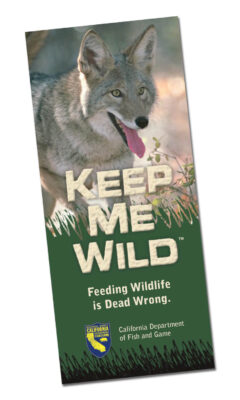 Did you know, according to the California Department of Fish and Wildlife, “California has more native animal and plant species than any other state in the nation and is also home to the greatest number of endemic species, those that occur nowhere else in the world[?]” And the Eastern Sierra (principally Inyo and Mono counties) which covers almost 10% of California’s land area is home to about 50% of these species.
Did you know, according to the California Department of Fish and Wildlife, “California has more native animal and plant species than any other state in the nation and is also home to the greatest number of endemic species, those that occur nowhere else in the world[?]” And the Eastern Sierra (principally Inyo and Mono counties) which covers almost 10% of California’s land area is home to about 50% of these species.
Bishop lies in the heart of the Eastern Sierra in the Owens Valley. It is nestled between two enormous mountain ranges and guests of our beautiful town are awestruck by these majestic mountains on either side. They are also thrilled to find easy access to alpine lakes, forest trails, flowering meadows, rocky outcrops, and high-desert scrubland—home to all sorts of wildlife.
The topography and geography our area is so diverse, ranging from below sea level in Death Valley to over 14,000 feet in the Sierra Nevada with highly variable precipitation at different elevations, that it includes five major biomes, broadly categorized by National Geographic as aquatic, grassland, forest, desert, and tundra, in a relatively small area. That means there’s habitat for a huge variety of wildlife.
What does this mean for you?
You are likely to see a lot of wildlife here and some that are found nowhere else on the planet. You will need to a do a little research and that’s why we created this page and hope it will help you.
Whether your love of nature is general, or you’re interested in a particular species we have recommendations, information, maps, and more that can help you find and experience wildlife in its natural habitat. Everything in the Eastern Sierra is seasonal; wildlife behaviors and patterns change with the seasons. So, study our guide below to know when and where to go for specific sightings or what you could see when you’re here.
Remember this!
ALL wildlife is dangerous, from the biggest bear to the smallest chipmunk there is an inherent risk when we disturb them. Just like us they are protective of their homes and families so, as all good wildlife enthusiasts do, we keep our distance, never try to feed or pet them, and we leave their habitats just as we find them.
Where to go and what to do
The list we’ve compiled is not exhaustive, but aims to cover as many interesting and notable species that live in the Eastern Sierra. The emphasis is on species residing in the Owens Valley and in the Sierra Nevada and White Mountains above Bishop. A few species of note from neighboring areas such as Yosemite Valley and Mono Lake (northwest of Bishop) and Death Valley (southeast of Bishop) have also been included.
What to bring and do when walking or hiking looking for wildlife:
• Take plenty of water and snacks.
• Store food in scent-proof packaging inside a backpack.
• Wear layers and sturdy shoes.
• Wear a hat and apply sunscreen – even in winter.
• Carry binoculars, a spotting scope, and telephoto lens – most sightings will be at a distance.
• Pack a small camp chair or pad to sit.
• ALWAYS tell someone where you are going and when you expect to be back.
• NEVER try to feed or pet a wild animal.
It’s good for you!
Being in a quality natural environment and seeing wildlife living free is a natural antidote to stress and anxiety. It’s proven. Our natural world has restorative powers; and we have a lot of nature and wildlife out here. We call it our big backyard. We know it well and we love to share it. We wish you safe and successful wildlife spotting!
Large Mammals
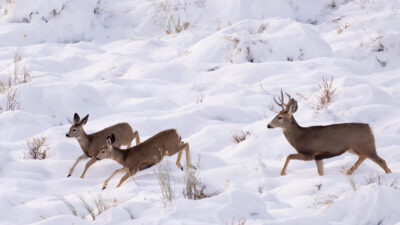
Deer moving through snow. Photo: John Paul DeRousseau
The large mammals of the Eastern Sierra each have distinct and different habitats and are often contained in specific locales in the region, either naturally by habitat or by management agencies to protect them and their habitats. In the guide below we have described each and provided a little historical information about some species that live here. The locations specified are either the only place the species can be seen or the best place for a possible sighting.
When viewing wildlife, please keep a safe distance and never feed or attempt to touch any wild animal. Experienced wildlife enthusiasts understand and respect the animal’s territory and behaviors.
Click on the hotspot button below for a virtual map tour of potential viewing sites.
Click the toggle buttons below for details about each animal and where you might see the wildlife in our area.
Sierra Nevada Bighorn Sheep
Ovis canadensis sierrae

Large herd of Sierra Nevada bighorn sheep
The majestic Sierra Nevada bighorn sheep are endemic and occur only in the Sierra Nevada of California. They are known for their agility and strength and possess an exceptional ability to climb steep, rocky terrain to escape predators such as mountain lions, coyotes, and golden eagles. A distinguishing feature of both males and females is their massive, curled horns, with the horns on rams being much larger and more curled than on the ewes. Their coat color varies from light brown to dark brown with a white rump and lining on the back of all four legs.
The Sierra Nevada bighorn sheep live primarily on the eastern slopes of the range from as low as 4,700 feet in elevation to as high as 14,000 feet. Habitat occurs in alpine meadows, grassy mountain slopes, and foothill country near rugged, rocky cliffs and bluffs. The animals prefer open areas with high visibility characterized by steep slopes and sparsely vegetated rocky outcrops. They rely on keen eyesight and a supreme ability to reach high rocky perches quickly to escape predation.
They are gregarious by nature and often found in groups, which change in size and composition with the season. Males tend to live in small groups or alone for most of the year, while females and their offspring form larger groups. In winter the groups join when the males compete for dominance and the opportunity to mate.
Most bighorn descend to their lowest elevation during the winter with some hardy individuals occupying the harsh, high ground year-round. The winter range of the Wheeler Ridge herd comes relatively close to the Owens Valley floor, which provides the best chance for catching a glimpse of these remarkable animals.
This species has faced severe threats principally from disease carried by domestic sheep introduced to the area in the late 1800s, and some habitat loss and predation. In just over 100-years the species was almost wiped out. As late as 1870, records show that about 1,000 individuals in several healthy herds inhabited a huge swath of the high Sierra, from Sonora Pass south to Olancha Peak. In 1970 only two herds remained. By 1995 only 105 individuals survived, and the species was listed as endangered. Today, after tireless work by the California Department of Fish and Wildlife and volunteers of their recovery program, more than 600 animals live in these mountains with healthy herds covering an area larger than 1,500 square miles from west of Bridgeport to west of Olancha.
Tips for potential sightings
Best locations: Rocky outcrops at the base of the Sierra Nevada below Wheeler Ridge
Best season: Winter
Best time of day: Daytime
Probability: Low
PRO TIP! Slowly scan the cliff and rocks for movement and flashes of white
Desert Bighorn Sheep
Ovis canadensis nelsoni
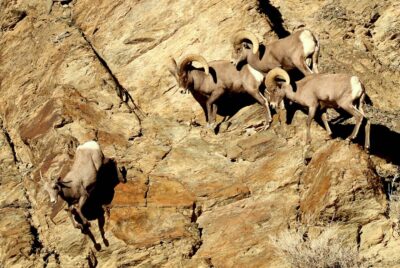
Group of desert bighorn sheep on a steep cliff. Photo: @buhlermarilyn
The desert bighorn sheep in the Eastern Sierra roam the White Mountains east of Bishop above the Owens Valley. They are a subspecies of bighorn sheep and distinctly different to the Sierra Nevada bighorn sheep that live in the mountains on the western side of the valley. Their range covers a much greater area of the deserts of the southwest extending into the drier Mojave, Sonoran, Chihuahuan, and Great Basin deserts across seven states. They are a majestic symbol of the rugged, mountainous Southwestern USA.
Their large, curling horns are a defining feature of male sheep. Both males and females develop horns soon after birth, but only males produce the massive horns that can grow to 3-feet in length and a foot in circumference at the base and weigh up to 30-pounds. By contrast the females’ horns are much lighter with less curl. Males do not defend territory, but battle using their impressive horns for dominance and access to particular females.
Desert bighorn sheep can be found in a multitude of terrains within the Eastern Sierra. From rocky hillsides and steep cliffs in the White Mountains to less precipitous desert scrublands near Bishop in the Owens Valley. These sheep have adapted well to these contrasting habitats. They prefer steep, rugged terrain with good visibility that allows them to easily spot predators. They have keen eyesight, and their exceptional climbing ability is made possible by unique concave elastic hooves that give them great speed and agility on rocky terrain.
One of the defining characteristics of the desert bighorn sheep is their exceptional adaptability to high temperatures and arid climates. Their bodies are designed to conserve water, reducing their need for frequent hydration. They possess a light-colored coat that reflects sunlight and helps them maintain a lower body temperature. Their large lungs facilitate effective oxygen absorption even at high altitudes.
Another notable characteristic is their distinct eating habit that echoes their adaptability. They are selective eaters, choosing plants that are high in moisture content to supplement their water intake. During drier periods, they rely on metabolic water from the breakdown of their food, enabling them to survive for extended periods without drinking water.
Tips for potential sightings
Best location: Rocky cliffs and outcrops in Silver canyon in the White Mountains
Best season: Winter
Best time of day: Daytime
Probability: Low to moderate
PRO TIP! Scan rocky ledges and outcrops for movement and flashes of white.
Black Bears
Ursus americanus

Black bear and cub
California is home to black bears. Their numbers have steadily increased during the last century after declining by 1900 due to human development and hunting. They have gradually moved into former grizzly bear habitat and now roam throughout the state. The entire Sierra Nevada range is prime habit for bears with most of their habitat here in the Eastern Sierra on U.S. Forest Service and National Park Service lands.
They typically live in the mountainous forested areas but will roam across diverse habitats to seek out different food sources. Bears are frequent visitors in the town of Mammoth Lakes and very occasional interlopers in the drier, warmer town of Bishop.
Black bears are omnivorous, consuming a variety of foods such as grasses, forbs, fruits, nuts, insects, and carrion. However, they do have specific habitat requirements. Black bears need large trees and cavities for denning, as well as mature and dense vegetation for cover. These requirements help ensure their safety and survival in their natural habitat.
A female black bear gives birth to two or three cubs, in her winter den, and her cubs will stay with her for about two years before venturing out on their own. Black bears can live up to 25 years and have few predators other than humans. One distinguishing characteristic of black bears is their smaller size compared to grizzly bears. They also have prominent ears, lack a mid-shoulder hump, and possess shorter claws. But you don’t want to get close enough to measure those!
It is important for humans to coexist with bears and take measures to prevent conflicts between the two species. This includes securing trash cans, not leaving food out in the open, and being ‘Bear Aware!” when camping or hiking in bear habitats. By respecting their habits and habitats, we can ensure the continued survival and conservation of black bears in the Eastern Sierra.
Tips for potential sightings
Best locations: Trails, forest, and meadows in the middle elevations of the Sierra Nevada
Best season: Spring
Best time of day: Dawn & dusk
Probability: Moderate
PRO TIP! Keep your distance and don’t surprise a bear if it is unaware of you. If it is focused on you try to appear large, wave your arms slowly, and speak calmly to it—identifying yourself as human. Turn sideways and move away slowly.
Here’s a great reference site for staying safe around bears.
Mountain Lions
Felis concolor

Mountain lion climbing tree. Photo from CDFW.
The mountainous and forested landscape of the Eastern Sierra is home to the elusive mountain lion, a species remarkably well adapted to the rugged terrain and diverse ecosystems found in this area. It provides ample cover for these stealthy predators, allowing them to effectively stalk their prey. Mule deer, which are abundant in the Eastern Sierra, are their primary food source. They will also consume other small predators like bobcat and coyote and prey on jackrabbits, cottontails, rodents, and birds.
Mountain lions are predominantly crepuscular, being most active during dawn and dusk when their prey is most vulnerable. However, it’s not uncommon for them to be active at any time of the day or night depending on food availability. They are primarily solitary and territorial and will aggressively protect and defend a den and offspring.
Males and females differ in size and extent of range. Females are smaller than males weighing on average 88lbs with a home range of about 39-square-miles. Males tip the scales at 128lbs and maintain a home range 2-3 times greater than females. It’s almost impossible to determine the gender just by looking at one in the field.
It’s best to keep your distance, appear as large as you can, and back away slowly if you encounter a mountain lion in the wild. Never run. No verified attack on a human has ever been recorded in the Eastern Sierra.
In 2018 monitoring by the California Department of Fish and Wildlife of mountain lion in the area of the Sierra bighorn habitat resulted in the highest count of individual mountain lions there since monitoring began. They documented 37 lions in a small area of the Eastern Sierra and believe that many more inhabit canyons and lower montane forest of the Sierra Nevada above Bishop.
Despite their elusive nature, mountain lions play a crucial role in maintaining balance in the local ecosystems. Through their predation on deer, they help control the population levels of this species and prevent overgrazing of vegetation. This role underscores the importance of conserving their habitats and ensuring their survival in the Sierra Nevada. They are not just part of our natural heritage but also vital components of its ecological health.
Tips for potential sightings
Best location: Canyons at the base of Wheeler Ridge above Round Valley
Best season: Fall to Spring
Best time of day: Dawn & dusk
Probability: Very low
PRO TIP! Sightings of mountain lion are rare, but if you suddenly encounter one on a trail immediately pick up children and pets, make yourself appear large, wave your arms, back away slowly. Never run!
NOTE: Please report any sighting of mountain lion to the nearest California Department of Fish & Wildlife office; in Bishop go to 787 N Main St, Bishop, CA 93514 or call (760) 872-1171.
Wild Horses
Equus ferus
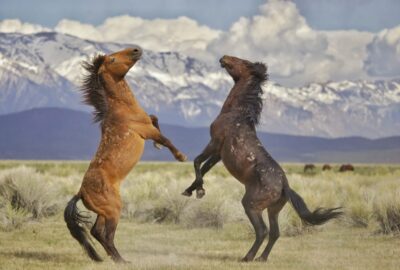
Wild horses near Benton, CA. Photo: Bert Dennison
Popularly referred to as ‘mustangs’ the wild horses are technically not wild animals, being descended from domestic animals, but are managed as wildlife and are a federally protected species. In the Eastern Sierra a large herd roams free near Montgomery Pass in an area north of Bishop just off SR-120 between Benton and Mono Lake.
Horses range in color from light gray to dark reddish-brown. A common color classification is known as ‘dun’ and may include other markings such as spots, stripes, and darker lower legs. Their coloring allows them to blend in with the landscape. Wild horses tend to be slightly smaller and stockier than modern domestic horses and are known for their hardiness, being able to withstand harsh conditions such as drought and snowfall.
They typically live in small bands or family groups consisting of a dominant stallion, mares, and their offspring. They have adapted to a nomadic lifestyle due to the sparse vegetation in the Eastern Sierra and northwestern Nevada. This lifestyle involves moving from place to place in search of food and water.
The wild horses of the American west are descendants of domesticated horses brought to the western United States by the Spanish explorers in the 16th century. It is believed that the first mass release of horses by the Spanish occurred in what is present-day New Mexico when the Native Americans of the Rio Grande Valley ousted the Spanish in the 1680 Pueblo Revolt. As the Spanish withdrew, they left behind about 1,500 horses.
These horses were well suited to the dry, open landscape of the American west. They, and countless others released in those early years, and their descendants, thrived and migrated throughout the Great Plains and Southwest.
The Montgomery Pass population is particularly fortunate that they live in a big area of just under 51,000 acres of protected land (under the auspices of the Bureau of Land Management BLM) with very low human habitation. In the last 30-years they have never been rounded up for removal (herd reduction) and their population is entirely managed by mountain lion predation and natural factors. Conservationists point out that protecting apex predators (mountain lion) is a key factor in managing wild horse populations.
The rugged mountainous terrain of the Eastern Sierra has proven to be very suitable for them and they have developed unique habits and characteristics that exemplify their resilience and adaptability. They have become an integral part of the local ecosystem, contributing to its biodiversity.
Tips for potential sightings
Best location: Wild Horse Meadow, off SR-120 about 30-miles west of Benton, CA
Best season: Spring through Fall (This road is closed in winter.)
Best time of day: All day
Probability: High
PRO TIP! Do not try to approach, feed, or pet the horses. They are wild animals. Keep still and quiet and watch from a safe distance.
Tule Elk
Cervus canadensis nannodes

Tule Elk
Tule Elk, the smallest of the North American subspecies of elk, are not native to the Eastern side of the Sierra Nevada range. Named for the tule reeds on which they feed, the tule elk were widespread in the Central Valley on the western side of the range, numbering as high as 500,000 when the first settlers arrived in the early 1800s. By 1870 they were thought to be extirpated, but in 1875 a single breeding pair was discovered in the tule marshes of what was then Buena Vista Lake.
Protection of the pair and conservation efforts resulted in a small herd within 20-years and, thereafter, an attempt to establish the species in Yosemite National Park. By 1933 the animals were deemed to be a danger to visitors and infrastructure and the entire herd of 26 animals was moved, in individual crates, to the Eastern Sierra. The Owens Valley, characterized by its vast open spaces, lush meadows, and freshwater springs, is an ideal habitat for these majestic creatures and they have since thrived.
Tule Elk are not migratory animals and tend to stay within their established territories throughout the year. They are most active during dawn and dusk. During the hottest parts of the day, they tend to take shelter under trees or in the cooler mountainous regions. They are herbivores, with a diet consisting primarily of grasses and forbs but will also consume tree bark and branches during leaner winter months.
During the non-breeding season, males and females live separately, forming same-sex groups. The males, known as bulls, form small groups or live solitarily while the females, or cows, live together in larger herds with their calves. In breeding season, or rut, the bulls compete for dominance to mate with the cows.
Their presence has been contested over the years. Farmers wanted the elk removed as they damaged crops and fences and proposed hunts to reduce the population. Preservationist opposed the hunts and objected to herd reduction. Today the species is protected and, under the 2018 Elk Conservation and Management Plan, the California Department of Fish and Wildlife works to keep the elk numbers to between 360 – 490 animals in six sub herds that exist in the valley between Bishop and Lone Pine. The herds are often seen on the irrigated lands alongside the US-395 highway that runs through the Owens Valley.
Tips for potential sightings
Best location: Wildlife viewing areas on both side of US-395 at Tinemaha Creek, 7-miles south of Big Pine.
Best season: Spring through fall
Best time of day: Dawn & dusk
Probability: High
PRO TIP! Wide roadside pull-outs exist on both sides of the highway, a safe distance from the roadway, that allows for wheelchair or disabled access.
Mule Deer
Odocoileus hemionus
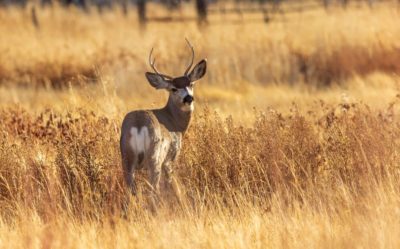
Mule deer in fall
Mule deer, a distinct species native to the Western North America, are a common sight in the Eastern Sierra. Known for their large mule-like ears from which they derive their name, these deer have adapted to a wide range of habitats within these areas.
Two large herds traverse the range above Bishop, the Round Valley herd and the Gooddale herd, and have healthy populations of near 3,000 and 5,000 individuals respectively. Three more herds range high into the Sierra Nevada in summer and through Mono county and east into Nevada in winter have a further 5,000 individuals.
The Eastern Sierra provides an ideal ecosystem for these creatures, offering a varied diet and abundant resources. In the high-altitude landscapes they are often found browsing on shrubs and herbaceous plants, their primary food sources. During fall they descend to the lower elevations of Bishop and Owens Valley in search of warmer climates and greener pastures to escape the harsh, snowy winters in the mountains. This annual journey is also influenced by the breeding cycle and the need for fawns to access nutrient-rich food sources for growth.
Mule deer are most active during dawn and dusk and their keen sense of hearing and smell, accompanied by their ability to make quick and erratic leaps, called stotting, make them highly capable of evading threats. One of the most serious threats to deer is from vehicle collisions on US Highway 395. They frequently cross the highway to get to their winter grounds and this puts both them and motorists at great risk.
A few families of mule deer have become accustomed to easy food sources in Round Valley and remain in the valley year-round.
Tips for potential sightings
Best location: Round Valley
Best season: Winter
Best time of day: Dawn & dusk
Probability: Very high
PRO TIP! Take a leisurely auto tour through the small settlement of Pine Creek Village (also known as Rovana) where deer are often seen foraging on the grass and scrub.
Coyote
Canis latrans

Coyote in winter
The coyote is perhaps the least appreciated wild animal in North America where it is native and abundant. They play a major role in keeping rodent populations under control and are an important part of our ecosystem.
The habitat of the coyote in this region varies greatly. They are found in a multitude of settings from desert lowlands of Owens Valley to the alpine environments around Bishop. These adaptable creatures have developed a tolerance for a broad spectrum of weather conditions, from freezing winters to scorching summers. Their coat, which changes from a light grey or tan color in summer to a dense, woolly coat in winter, assists them in adapting to these changes in climate.
Coyotes are primarily nocturnal animals and can often be heard communicating with each other at dawn or dusk through howls and yips. These vocalizations serve various purposes such as signaling territory, communicating with pack members, or expressing joy. Yet despite their social tendencies, coyotes are generally solitary creatures. They are highly territorial and mark their ranges with urine.
Coyotes are, by nature, fearful of humans and according to wildlife experts they’re just “looking for food, not a fight.” However, access to human food and garbage can change their behavior. They become less fearful and may start harassing pets and livestock. They are omnivorous, opportunistic eaters that hunt and scavenge. Their prey consists largely of rats, mice, squirrels, and other small mammals. They have been known to take down adult deer, when hunting as a pack. Their diet is supplemented by fruits and vegetables as available, most often in the form of garbage.
In coyote territory it is important to keep pets on a leash, indoors at night, secure garbage, store all food indoors, and clean up any food leftovers outdoors.
Tips for potential sightings
Best location: Open fields on outskirts of Bishop
Best season: Fall through Spring
Best time of day: Dawn & dusk
Probability: Very high
PRO TIP! Take a walk along any of the canal paths around town, stand quietly and listen for their calls. Keep pets on a leash and small children within reach.
Request a FREE Bishop Information Guide
Look!!! Let’s plan a Death Valley Trip. Ask about including a visit from Bishop.
And don’t forget to check out all our great lodging options.
Read and study these pages, download the brochures and maps, and plan a trip to Bishop and the Eastern Sierra. Call us: (760) 873-8405, or email us: and let us help you choose your future adventure. We look forward to meeting you then!
Please follow us on social media:
Facebook | TikTok| YouTube | Instagram
Check out the latest blog posts on BishopVisitor.com!
Small Mammals
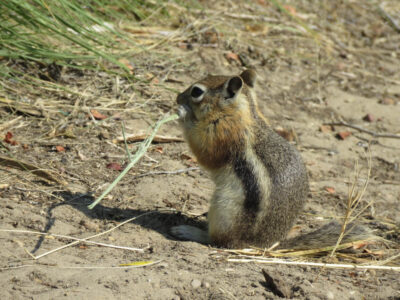
Golden Mantled ground squirrel. Photo: Gigi de Jong
Like the large mammals of our region the small mammals have different, characteristics, habits, and habitats. From diurnal, crepuscular, to nocturnal and desert-dwelling to forest living there is an abundance of small creatures in our region because of our diverse environment and large natural, protected landscape.
The small mammals of the Eastern Sierra are no less dangerous than the large animals. A bite from a small predator or rodent can have serious consequences and some such as, raccoons, bats, skunks, bobcats, and foxes may carry rabies. Luckily these wonderful creatures are generally fearful of humans and will try to avoid all interaction. None will try to attack humans and a bite will be in self-defense of itself and/or its offspring.
Sightings of many of these species are usually by chance and unexpected. Searching for and finding the more elusive species often requires much research and preparation and plenty of time to hike, sit, and wait. Nevertheless, a walk along the canal paths near town or trails along local creeks and in the mountains usually results in sightings of many of the more prevalent species.
Click on the hotspot button below for a virtual map tour of potential viewing sites.
Click the toggle buttons below for details about each animal and where you might see the wildlife in our area.
Gray Fox
(Urocyon cinereoargenteus californicus)

Gray fox. Photo: VJAnderson, Wikimedia
The gray fox is a small, dog-like mammal, with a sharp pointed face and ears, an agile and lightly built body, a coat of lustrous long fur, and a large bushy tail. It is common in the Eastern Sierra where its habitat covers the brushy areas of the foothills and forested mid-level montane regions of the Sierra Nevada. Like most foxes they are primarily nocturnal and sometimes crepuscular (active at dawn and dusk) and highly elusive. They are seldom seen but often heard (if you’re familiar with their sounds) in the late evenings and at night; they are quite vocal, with a repertoire of howls, screams, barks, and growls.
They grow to about 40-inches in length (about 1/3 of that is the tail) and weigh 8- to 10-lbs. The gray fox is primarily carnivorous preying on small mammals, rodents, and birds, but will eat fruit and berries. They typically hunt at night when their preferred prey is moving about; their strong, swift runs are often punctuated by long, silent pauses of still hunting.
The gray fox is a solitary hunter and only socializes during mating season. They are usually monogamous and breed once a year producing a litter of 2-7 kits. The kits are trained and ready to hunt by about 4-months and will disperse from the family den at about 9-months. Gray foxes generally live between 6- to 10-years.
Tips for potential sightings
Best location: Buttermilk country and Tungsten Hills
Best season: Year-round
Best time of day: Late evening and nighttime
Probability: Very low
PRO TIP! Sit quietly at dusk and wait until nightfall near a water source as their dens are often near water.
Kit Fox
Vulpes macrotis
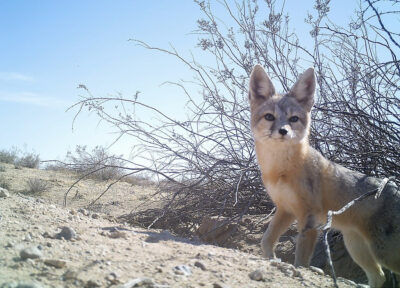
Kit fox near Ridgecrest. Photo: BLM
The kit fox is the smallest of the Vulpes fox species. They are cute and curious and are often seen in Death Valley National Park. They have been known to frequent campsites and, according to rangers, are not always looking for food, but merely inquisitive. If you see one at your campsite, please DO NOT feed it.
About the size of the housecat, the kit fox has very large ears that give them exceptional hearing and help to dissipate body heat, a bushy tail, and stiff tufts of hair on their paws to protect against ground heat and provide traction on sand. They are sometimes crepuscular (active at dawn and dusk) and mostly nocturnal and spend their days in underground dens to escape the desert heat.
Kit foxes seldom need to drink as they obtain almost all their water from their food. They hunt rabbits, kangaroo rats, other rodents, and insects, and occasionally eat cactus fruits. They will eat human food, so it is up to us to see that our food is not available to them.
Kit foxes are socially monogamous and not particularly territorial with multiple dens across a home range. They prefer to live in pairs or small family groups, but do tend to hunt and forage on their own.
Tips for potential sightings
Best location: Campsites in Death Valley National Park
Best season: Year-round
Best time of day: Late evening and nighttime
Probability: Low to moderate
PRO TIP! Sit quietly at a campfire on the outskirts of a campground. Kit foxes are known to be attracted by the fire.
NOTE: Free permits are required for dispersed camping, but campfires are prohibited.
Bobcat
Lynx rufus
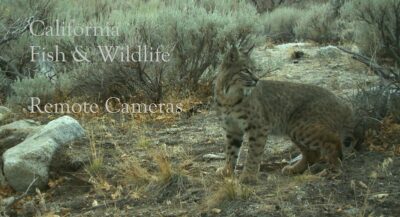
Bobcat. Photo: CDFW Remote Camera.
Bobcats are twice as big as domestic cats with tufted ears, large paws, and big, ruff-like cheeks. Their coloring ranges from tan to grayish-brown with distinguishing dark streaks and spots that act as camouflage. They are named for their distinctive stubby or ‘bobbed’ tail.
Bobcats are excellent climbers and are often found perched on high rocks or in trees. Their preferred habitat is dense brush in deciduous and coniferous forests with rocky ledges. They are primarily crepuscular (active at dusk and dawn) and hunt by ambushing their prey from high perches. They are especially fond of rabbits and hares, but will also eat rodents, birds, bats and occasionally an adult deer.
They are very elusive and solitary animals that try to avoid contact with humans. Females choose a secluded den to raise a litter of one to six young kittens, which will remain with their mother for 9 to 12 months. During courtship, the otherwise solitary bobcat may have a variety of different calls including caterwauls, yowls, growls, hisses and screams. Male and female bobcats have territories that they mark with their scent during this time. After mating they separate, and the female raises the kittens on her own.
Tips for potential sightings
Best location: Buttermilk country and Tungsten Hills
Best season: Year-round
Best time of day: Sunset and sunrise
Probability: Very low
PRO TIP! Sit quietly at dusk or dawn in or near a riparian area with rocky outcrops.
Raccoon
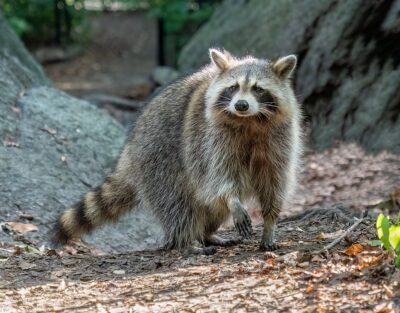
Raccoon seen in daytime, which is rare. Photo: Rhododendrites
Procyon lotor
Raccoons are small, nocturnal mammals commonly found throughout the Eastern Sierra region. They are easily identifiable by their black mask and ringed tail. Raccoons are highly intelligent and curious creatures. They are also very adaptable and can live in a variety of habitats, from forests to cityscapes.
The raccoon’s diet consists of a variety of foods, including fruits, plants, insects, berries, shellfish, and frogs. They’re also known to eat human food and will often rummage through garbage cans. Raccoons usually make their homes in tree cavities or burrows. They are excellent swimmers and climbers, and will often remain in their dens for extended periods of time during the winter months.
Raccoons are solitary creatures, except for mothers with their young. Females have a 65-day gestation period and give birth to two to five kits, usually in the late spring. The young raccoons often stay with their mother for about a year.
Tips for potential sightings
Best location: Quiet streets on the edges of towns
Best season: Spring through Fall
Best time of day: Nighttime
Probability: High
PRO TIP! Go for a walk well after dark in outlying settlements such as Rovana and Wilkerson
Yellow-bellied Marmots
Marmota flaviventris
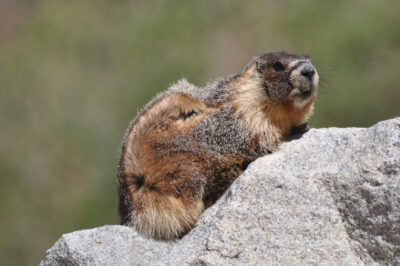
Yellow-bellied marmot peers over a rock. Photo: Ron and Barbara Oriti
Yellow-bellied marmots, also known as rock chuck, are large ground squirrels in the marmot genus. They are diurnal and are common in the mountains of the Sierra Nevada. Yellow-bellied marmots usually weigh from 4- to 12-lbs when fully grown, with males typically weigh more than females. Their weight fluctuates greatly during the seasons as they fatten up in summer and hibernate in winter.
They live in colonies of between 10 and 20 individuals in rock piles and talus fields. They use their rocky homes for shelter, sunning, and observing. Yellow-bellied marmots are mainly herbivorous, their diet is composed mostly of leaves and flowers, but can also include fruits, grains, and legumes. They occasionally eat insects, spiders, and bird eggs.
Yellow-bellied marmots are social and use loud whistles to communicate with each other, especially when alarmed. When looking for marmots one will often hear them before seeing them. Look for feet and faces peering over the rocks.
They have broad flat heads with dark fur on the head and back. Their throats, necks, and bellies have bright, yellow-ish fur (hence their name) and sport a bushy, reddish-brown tail. They often have a frosty look with white patches on the nose and face. Their coat has long, coarse outer hairs and short, wooly underfurs.
Tips for potential sightings
Best location: Talus and rock piles around North Lake
Best season: Summer
Best time of day: Daytime
Probability: Moderate to high
PRO TIP! Drive to North Lake parking area and park near the lake. Walk quietly toward the campground (about ¼-mile) and near the talus field north of the road listen for their whistling call. Stop quickly and scan the rocks.
California Ringtail
Bassariscus astutus

California ringtail on a small rocky ledge. Photo: Brooke Smith
Ringtails, sometimes called ringtail cats, are not cats but part of the raccoon family (Procyonidae), although their behavior and appearance are more like a fox. These small nocturnal animals, smaller than most house cats, are secretive and elusive. They prefer to inhabit rocky areas with plenty of hiding spots, such as cliff crevices and hollow logs. However, their distinctive tracks, marked by four toes and a palm pad, can often be seen in the soft dirt or sand around their habitat.
Ringtails are extremely agile and adept climbers using the ability to rotate their hind feet 180 degrees that enables them to descend trees headfirst–a rare ability among mammals. Their long, bushy tails provide balance as they navigate the rocky terrain and trees in their habitat. Diet consists primarily of small mammals, insects, and occasionally fruits. They are solitary and territorial, marking their range with scent glands located at the base of their tail.
Tips for potential sightings
Best location: Forested, rocky areas near settlements
Best season: Year-round
Best time of day: Twilight and nighttime
Probability: Unlikely
PRO TIP! Take a walk up Lower Rock Creek from Paradise just after dark and sit quietly near a rocky outcrop.
Striped Skunks
Mephitis mephitis
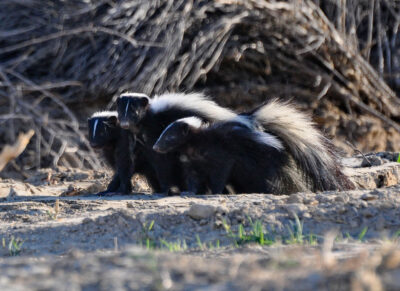
Family of three skunks out during the day. Photo: Ron and Barbara Oriti
Striped skunks are found throughout North America. A small mammal, they are easily distinguished by their black coat with double white stripe running from the back of the head to the end of the tail. They are best known for their ability to spray a liquid with a strong, unpleasant smell. This is a defense mechanism and they rarely, if ever, seek conflict. And they will indicate their displeasure, by standing tall and raising the tail high, well before they spray.
Skunks are found in a variety of habitats, including grasslands, forests, and suburban areas. They have an excellent sense of smell and hearing, but poor vision, being unable to see objects more than about 10-ft) away, making them vulnerable to being run over by cars. Give a skunk a ‘brake’ when you see one crossing the road.
They are omnivorous and their diet changes with the season. They eat insects and larvae, earthworms, grubs, small rodents, lizards, salamanders, frogs, snakes, birds, moles, and eggs. They also commonly eat berries, roots, leaves, grasses, fungi and nuts.
Skunks are crepuscular, solitary animals when not breeding, though in colder parts of their range, they may gather in communal dens for warmth. During the day, they shelter in burrows which they can dig with their powerful front claws.
Tips for potential sightings
Best location: Quiet streets on the edges of towns
Best season: Spring through Fall
Best time of day: Just after dusk
Probability: High
PRO TIP! Go for a walk just after dark in outlying settlements such as Rovana and Wilkerson
American Pika
Ochotona princeps
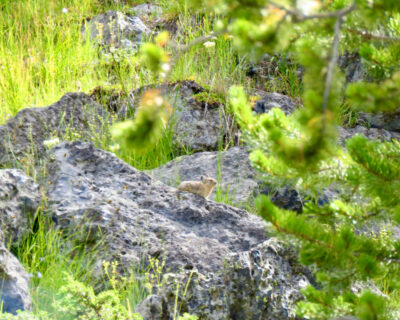
Tiny American pika on boulder. Photo: Gigi de Jong
The American pika, a relative of rabbits, occupies rocky environments in the mountains of western North America. Pikas live at higher elevations above 8,000-ft in the Eastern Sierra. Their preferred habitat is rockpiles and talus fields where they create dens to survive year-round in this harsh environment. Because of what scientists call their ‘furnace-like metabolism’, they are one of the few mammals that can survive in alpine terrain for their entire lives.
They are herbivores, eating a variety of plant material, including forbs, grasses, sedges, shrub twigs, moss, and lichen. Their unique behavior of creating ‘haypiles’ in their dens is a method for survival during winter.
American pikas have a round body with short limbs, rounded ears, and no visible, external tail. These diminutive rock-dwelling animals are diurnal (active during the day) with peak activity periods during the cooler parts of the day. They are typically solitary and defend their territories using a series of shrill calls to communicate.
Tips for potential sightings
Best location: Talus and rock piles around North Lake
Best season: Summer
Best time of day: Cool part of day
Low to moderate
PRO TIP! Drive to North Lake parking area in the early morning and park near the lake. Walk toward the campground (about ¼-mile) and stand or sit quietly at the edge of the talus field north of the road.
Hares & Rabbits
There are several hare (commonly referred to as jackrabbits) and rabbit species that inhabit the Eastern Sierra. The species described below are the most notable of that live here. They are all members of the animal family Leporidae that consists of over 70 species of extant hares and rabbits worldwide. Their habitats and ranges overlap in some cases, but they each have distinctive characteristics and habits. Their populations vary over the years depending on weather changes and human habitation and activity.
Some key differentiators between hares and rabbits are:
– hares are larger with bigger ears and longer legs and feet,
– hares are born precocial, that is, fully furred, well developed, capable of moving on its own,
– rabbits are born altricial, that is, blind, hairless, and unable to fend for themselves,
– rabbits tend to freeze and rely on camouflage at signs of danger,
– hares use their extraordinary speed and agility to escape predation,
– hares are usually solitary, except for mating, and
– rabbits are social and live in communal dens.
Black-tailed jackrabbit (Lepus californicus)

Black-tailed jackrabbit in dry grass. Photo: Scott Rheam, U.S. Fish and Wildlife Service
The most common hare in the Eastern Sierra is the black-tailed jackrabbit. Also known as the American desert hare, its range covers a large area of the Eastern Sierra from low elevation scrubland to higher elevation mixed grassland. They prefer moderately open areas dotted with shrubs for cover during daytime feeding and open areas for foraging at night. They are particularly well adapted to arid environments, with large ears that help dissipate heat and a diet that provides them with much of the water they need.
They are often called ‘racy’ for their upright ears and flat-footed gait that is less ‘hoppy’ than that of most rabbits. At top speed a black-tailed jackrabbit can reach 40mph and can leap up to 20-feet in a single bound. They often leap high in the air to check their surroundings and confuse predators, a behavior known as ‘stotting.’
White-tailed jackrabbit (Lepus townsendii)
An uncommon, year-round resident of the Eastern Sierra, the white-tailed jackrabbit is the third-largest North American hare and largest species called ‘jackrabbit.’ Found at upper elevations of the Sierra Nevada up to 8,000-ft, they prefer sub-alpine coniferous meadows, and may move seasonally into scrubland at lower elevations. They are solitary except for breeding season when several males will court a female. Their large ears, besides providing excellent hearing, are filled with blood vessels that help dissipate heat and regulate their body temperature.
These hares are nocturnal, living shallow depressions under vegetation. They emerge after dusk to feed on grasses and mixed green vegetation. During the winter, they can subsist on woody vegetation, demonstrating their ability to adapt to seasonal changes. They are known for their incredible speed and can reach up to 35 miles per hour all while following a zig-zagging course. They use this speed and agility to escape from predators, along with their ability to leap up to 20 feet in a single bound.
Snowshoe hare (Lepus americanus)
The snowshoe hare is named for its large, furry feet that act like snowshoes, enabling it to travel easily over deep snow. They are found in forested and alpine environments, where their thick, white winter fur provides excellent camouflage against the snow. In the summer, their coat changes to a rusty brown color, helping them blend in with the vegetation; they always retain the black outline on their ears.
They are primarily nocturnal, and spend their days hidden in dense vegetation or burrows, emerging at dusk to feed on a variety of plant material, including grasses, leaves, and twigs. In the winter, when food is scarce, they may also eat bark and buds.
Nuttall’s (or mountain) cottontail (Sylvilagus nuttallii)
Nuttall’s Cottontails are grayish-brown in color, with a white belly and a characteristic white, cottony tail. These rabbits are crepuscular, active during the twilight hours of dawn and dusk, and favor open habitats, such as grasslands, meadows, and desert scrub up to elevations as high 6,000-feet. They are herbivorous, feeding on a variety of grasses, forbs, and woody material.
Mountain cottontails don’t dig their own burrows, but use burrows abandoned by other animals to give birth to litters that average about 6 kits. They next and seek shelter in these shallow depressions that they line and cover with fur and dried grass. They are not especially social, but do congregate at popular feeding grounds. They have been observed climbing trees to feed and, it is thought, to drink water that forms on leaves from condensation.
Audubon’s (or desert) cottontail (Sylvilagus audubonii)
Audubon’s Cottontail, also known as the Desert Cottontail, is considered a ‘New World’ rabbit and common to the desert regions of the Western United States. They are grayish-brown in color, with a characteristic white, fluffy tail. These rabbits are primarily crepuscular and seldom active during the day, especially in the high desert of the Eastern Sierra. They are herbivorous, feeding on a variety of plant material, including grasses, forbs, and cacti. They are most often found in riparian zones in arid regions.
Each rabbit’s home range is relatively small, about 1-acre for females and 15-acres for males, and they do not dig large burrow systems like European ‘Old World’ rabbits. They occupy old, vacated dens dug by other mammals to give birth to their kits. They do gather in small groups to feed. Their large ears are used to regulate their body and heat and as ‘radars’ for sounds of predators. They are rarely seen outside their dens on windy days as this interferes with their ability to hear predators.
Tips for potential sightings
PRO TIP! Look for these species as you walk the trails in the Owens Valley and up on the High Sierra per the habitats described for each.
Squirrels & Chipmunks
The ubiquitous squirrel is a common sight in the Eastern Sierra. They are most often seen, and heard, in the warmer months during the day. Most are arboreal and very good climbers and others prefer rocky crevasses and holes in the ground. Where humans are often present, they have become habituated to human food. Please DO NOT ever feed them or any other wild animal.
Golden-mantled ground squirrel (Callospermophilus lateralis)

Golden Mantled ground squirrel. Photo: Gigi de Jong
The Golden-mantled ground squirrel is a small squirrel common to the Western U.S., including the Eastern Sierra. They are easily distinguishable by the golden-brown fur on their neck and shoulders, and the two white stripes that run down their sides. Although similar in appearance to chipmunks they are slightly larger and have no stripes on their head.
These diminutive squirrels are diurnal, active during the day, feeding on a wide variety of food, including seeds, nuts, fruits, insects, and even small vertebrates. They are often seen at campgrounds and are the tamest and bravest of the squirrels. Please do not feed them. Keep them wild. They prefer rocky or forested habitats, where they make their homes in burrows or under rocks. They hibernate more than half the year, relying on stored food and fat reserves to see them through the cold months.
Belding’s Squirrel (Urocitellus beldingi)
Belding’s squirrel, also known as the Belding’s ground squirrel, is a medium-sized squirrel that is found at the mid- to upper-elevations of the Sierra Nevada. These squirrels are brownish-gray in color with no stripes, mottling, or markings; they have small, rounded ears, and a relatively short, not bushy, tail.
Belding’s Squirrels are diurnal, active during the day. They are herbivorous, feeding primarily on grasses and forbs, although they will also eat insects and other small animals. These squirrels prefer open habitats, such as meadows and grasslands, where they dig extensive burrow systems for shelter and protection from predators. In the winter, they hibernate, emerging in the spring when food is more plentiful.
Least Chipmunk (Tamias minimus)
The least chipmunk is the smallest and most widespread chipmunk in North America. It is cute and tiny with distinctive white and brown stripes that run from the tip of its nose to the top of its tail, which it uses actively when running and posturing. They are less arboreal than other chipmunks and prefer sagebrush, bitterbrush, and other Eastern Sierra shrub habitats, where they make their homes in burrows with entrances concealed by rocks.
Least chipmunks are diurnal, active during the day, and feeding on a variety of food, including seeds, nuts, fruits, insects, and bird eggs. They are known for the large ‘middens’ that they create where they stash food. They don’t hibernate or store excess body fat, but enter a state of deep sleep called “torpor” and wake occasionally to eat throughout the winter.
Lodgepole Chipmunk (Neotamias speciosus)
The lodgepole chipmunk is slightly larger than the least chipmunk (described above) with coloring and distinctive stripes from nose to tail that appear similar at first glance. The body color is a brighter orange, tending to cinnamon on females, and the stripes are lacking the black stripe underneath the prominent white stripe. They prefer forested habitats, particularly pine forests, where they make their homes in burrows or in the hollows of trees. They can be found at elevations ranging from 4,900-ft to 9,000-ft in the Sierra Nevada.
They are omnivorous and active during the day (diurnal) and feeding on a variety of food, including seeds, nuts, fruits, insects, and bird eggs. The lodgepole chipmunks hibernate in winter, creating nests in burrows and cavities in trees, and emerge in spring when food is more plentiful.
Alpine Chipmunk (Neotamias alpinus)
The alpine chipmunk is found only in the high Sierra between Yosemite National Park and Olancha Peak. They have been observed between 7,800-ft to 12,800-ft elevation, but rarely below 8,200-ft. They have the characteristic coloring and striping of other chipmunks, but paler and more muted than the other species.
They nest in rocky crevasses and make use the micro-climate (i.e. higher temperatures) that rocks afford. They are excellent rock climbers but rarely climb trees. Alpine Chipmunks are diurnal, feeding during the day on grasses, seeds, nuts, forbs, and fungi; some nocturnal activity in summer has been reported. They stash food for winter when they hibernate intermittently, waking to eat some of their stash. They seldom drink or need water.
Tips for potential sightings
PRO TIP! Listen for their high-pitched calls, often alarm calls from our presence in their habitat, and scan the trees or forest floor looking for movement.
Kangaroo Rats
Chisel-toothed Kangaroo Rat (Dipodomys microps)
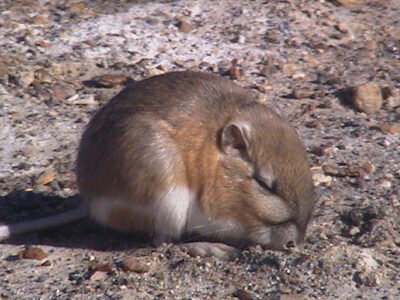
Chisel-toothed kangaroo rat foraging. Photo: David Syzdek
The chisel-toothed kangaroo rat is a delightful creature occurring in the Owens Valley and south into Death Valley. These small rodents are named for their long, chisel-like incisors, which they use to break open the hard seed pods that form a significant part of their diet. They are nocturnal and can be seen hopping around near campsites on their large, powerful hind legs–a form of locomotion that gives them their ‘kangaroo’ moniker.
They feed on leaves of shrubs and forbs by climbing into the shrubs to harvest the leaves. They consume the entire leaf in spring, but use their sharp incisors to shear the leaf later in the season when the leaves become too salty. This ensures they get the most water from the plant without ingesting salt. The seeds of the shrubs and forbs are gathered from the ground.
Panamint Kangaroo Rat (Dipodomys panamintinus)
The Panamint kangaroo rat is found in the high desert of the Owens Valley and south into the Mojave Desert, and east in the Panamint Mountains. Its preferred habitat is sagebrush, pinyon-juniper, and Joshua tree. Their kangaroo-like hopping gait give them their name and they are clay-colored with blackish patches on the face. Their long tail (almost 1 ½ times their body length) has a small tuft of hair on the end.
They have fur lined check pouches to carry large amounts of food that are kept separate to retain the moisture in the food. They are said to be a granivore, primarily eating seeds such as pinion pine, juniper berries, and other forbs, shrubs, and grasses and supplement with green shoots of shrubs and grasses. They derive all their water from their food and do not drink. They are, however, very good swimmers. Panamint kangaroo rats are nocturnal and do not hibernate.
Tips for potential sightings
PRO TIP! In high-desert Owen Valley campgrounds, such as Horton Creek near Bishop or Tuttle Creek near Lone Pine, sit quietly after dark and watch for movement in the scrub.
Resources
- California Department of Fish and Wildlife – Bishop Field Office.
- California Watchable Wildlife – Learn how to view native wildlife and habitats in a respectful way.
- Eastern Sierra Audubon Society – locals and visitors are welcome to join regular field trips, outings and seminars.
- Eastern Sierra Land Trust – More on the Round Valley Mule Deer Herd.
- Wildcare Eastern Sierra – Helping and healing injured wildlife.
- Strategies for Wildlife Living in the Desert – Blog post
- Keep Me Wild – CDFW program
- Keep Me Wild – CDFW downloadable brochure
Check these blogs for more interesting wildlife info
Bug's Life
Birds & Bees
Endangered
#VISITBISHOP GUEST EXPERIENCES
About the Author: Gigi de Jong
![]() Gigi is “crazy mad in love with Bishop.” Since moving here in 2006 she has made it her mission to participate in as many of the outdoor activities as possible. She learned to snowboard, improved upon her very average climbing skills, took long hikes, has driven up and down innumerable mountain roads and 4×4 tracks, cycled and occasionally tumbled down mountain bike trails, taken to the roads on a bicycle or motorcycle – sometimes for fun and sometimes to commute, and successfully completed her first attempt at a triathlon. She spent 10 months touring the western US and Canada on a bicycle and after 4,000 plus miles returned to Bishop – for the beauty of the place and the spirit of the community. “My soul belongs here,” she says.
Gigi is “crazy mad in love with Bishop.” Since moving here in 2006 she has made it her mission to participate in as many of the outdoor activities as possible. She learned to snowboard, improved upon her very average climbing skills, took long hikes, has driven up and down innumerable mountain roads and 4×4 tracks, cycled and occasionally tumbled down mountain bike trails, taken to the roads on a bicycle or motorcycle – sometimes for fun and sometimes to commute, and successfully completed her first attempt at a triathlon. She spent 10 months touring the western US and Canada on a bicycle and after 4,000 plus miles returned to Bishop – for the beauty of the place and the spirit of the community. “My soul belongs here,” she says.


